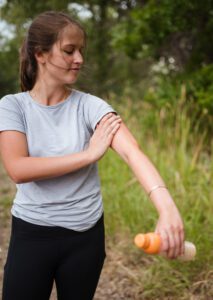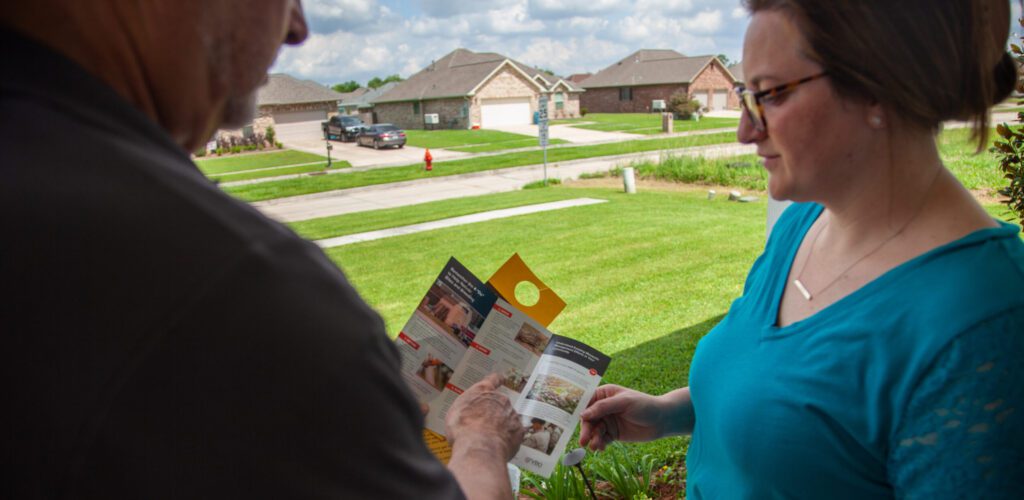Personal Protection & Property Maintenance Tips
 We’re all impacted by the presence of mosquitoes – in more ways than you might know. Itchy bites are often a harmless annoyance, but the spread of mosquito-borne disease can have disastrous consequences for both humans and animals. Proactive integrated mosquito management (IMM) is the most effective way to limit their populations. VDCI partners with city, county, and state governments as well as mosquito abatement districts and public health entities to protect residents and visitors to their community. Depending on the species of mosquito in your area, public education can play a critical role in preventing mosquito development and bites can be minimized with the use of EPA approved repellents and personal protective clothing.
We’re all impacted by the presence of mosquitoes – in more ways than you might know. Itchy bites are often a harmless annoyance, but the spread of mosquito-borne disease can have disastrous consequences for both humans and animals. Proactive integrated mosquito management (IMM) is the most effective way to limit their populations. VDCI partners with city, county, and state governments as well as mosquito abatement districts and public health entities to protect residents and visitors to their community. Depending on the species of mosquito in your area, public education can play a critical role in preventing mosquito development and bites can be minimized with the use of EPA approved repellents and personal protective clothing.
Mosquitoes Are a Threat to Public Health
You may have heard about common diseases like West Nile virus, malaria, Eastern Equine Encephalitis, Yellow Fever, Zika, dengue and others. It can be easy to brush off the transmission of these pathogens as extremely rare instances, but the reality is mosquitoes spread more disease than any other species on earth, resulting in approximately one million deaths annually. Victims of these diseases can experience severe complications, including flu-like symptoms, allergic reactions, brain and nervous system inflammation, permanent physical and mental disabilities, or birth defects. Mosquitoes are also responsible for transmitting deadly parasitic heartworms to cats, dogs, and other wildlife.
We Each Play a Role
Mosquitoes have existed on earth for millions of years and with over 3,000 unique species they won’t be eradicated any time soon. There are numerous ways to reduce mosquito populations in your area and they all begin with an understanding of species biology and empowering community members to take personal protective measures.
Eliminating Mosquito Habitat
 Mosquitoes require standing water to develop. A single female can lay anywhere from 200-300 eggs and utilize habitats as small as a bottle cap. When it’s hot outside these larvae can develop into biting adult mosquitoes in less than 4 days! Some of the sites we frequently find in backyards include clogged gutters, old tires, and potholes or depressions near sprinkler heads. You can do your part to help eliminate mosquitoes by emptying outdoor containers such as cups, buckets, flower pots, bird baths, and watering cans. Likewise, take steps to ensure water properly drains off of tarps, tables, and outdoor equipment during rainstorms.
Mosquitoes require standing water to develop. A single female can lay anywhere from 200-300 eggs and utilize habitats as small as a bottle cap. When it’s hot outside these larvae can develop into biting adult mosquitoes in less than 4 days! Some of the sites we frequently find in backyards include clogged gutters, old tires, and potholes or depressions near sprinkler heads. You can do your part to help eliminate mosquitoes by emptying outdoor containers such as cups, buckets, flower pots, bird baths, and watering cans. Likewise, take steps to ensure water properly drains off of tarps, tables, and outdoor equipment during rainstorms.
Personal Protection Against Mosquito Bites (Repellent and Clothing)
 While reducing mosquito habitat on your property can make a significant difference in the battle against mosquitoes, many species are capable of flying several miles to take a blood meal. Because of this it’s also important for you to wear protective clothing and use an EPA approved repellent when biting pressure is high or transmittable diseases have been identified in local populations. Wear light-colored clothing, closed toe shoes, long-sleeves, and long pants when spending time outside can reduce your likelihood of being bitten. This is especially important around dawn or dusk when mosquitoes tend to be most active. Bare skin on hands, ankles or face should be protected with repellent or covered when possible. For the safe and effective use of any product, always read the label and follow manufacturer guidelines.
While reducing mosquito habitat on your property can make a significant difference in the battle against mosquitoes, many species are capable of flying several miles to take a blood meal. Because of this it’s also important for you to wear protective clothing and use an EPA approved repellent when biting pressure is high or transmittable diseases have been identified in local populations. Wear light-colored clothing, closed toe shoes, long-sleeves, and long pants when spending time outside can reduce your likelihood of being bitten. This is especially important around dawn or dusk when mosquitoes tend to be most active. Bare skin on hands, ankles or face should be protected with repellent or covered when possible. For the safe and effective use of any product, always read the label and follow manufacturer guidelines.
Public Education Is Imperative
Public participation can play an important role in reducing local mosquito populations and preventing transmission of disease. The tools used to control mosquitoes are diverse and often misunderstood. Partnering with a professional mosquito management organization can help ensure community members receive the most accurate and effective information about the mosquito species, diseases, and tools used in your area. This is a core pillar in any successful mosquito control program that municipalities, health departments, churches, schools, and other community groups must prioritize when getting started.

The science behind mosquito management is foundational to everything we do and application strategies continue to develop as environmental conditions shift and management solutions become more advanced. Whether a project requires targeted ground operations or large-scale efforts using drones and aerial fleets, VDCI helps stakeholders design the most productive and economical approach.
Contact Us to Build A Public Education Program for Your Community
 Since 1992, Vector Disease Control International (VDCI) has taken pride in providing municipalities, mosquito abatement districts, industrial sites, planned communities, homeowners associations, and golf courses with the tools they need to run effective mosquito control programs. We are determined to protect the public health of the communities in which we operate. Our mosquito control professionals have over 100 years of combined experience in the field of public health, specifically vector disease control. We strive to provide the most effective and scientifically sound mosquito surveillance and control programs possible based on an Integrated Mosquito Management approach recommended by the American Mosquito Control Association (AMCA) and Centers for Disease Control and Prevention (CDC). VDCI is the only company in the country that can manage all aspects of an integrated mosquito management program, from surveillance to disease testing to aerial application in emergency situations.
Since 1992, Vector Disease Control International (VDCI) has taken pride in providing municipalities, mosquito abatement districts, industrial sites, planned communities, homeowners associations, and golf courses with the tools they need to run effective mosquito control programs. We are determined to protect the public health of the communities in which we operate. Our mosquito control professionals have over 100 years of combined experience in the field of public health, specifically vector disease control. We strive to provide the most effective and scientifically sound mosquito surveillance and control programs possible based on an Integrated Mosquito Management approach recommended by the American Mosquito Control Association (AMCA) and Centers for Disease Control and Prevention (CDC). VDCI is the only company in the country that can manage all aspects of an integrated mosquito management program, from surveillance to disease testing to aerial application in emergency situations.

